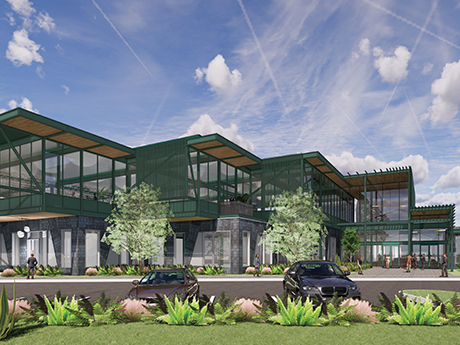By Ed Coury, senior managing director, RCS Real Estate Advisors
Open-air lifestyle centers can be defined as intentionally designed spaces that are set against beautiful landscapes and house high-quality dining, retail, entertainment, health and wellness uses.
These centers are being developed or redeveloped at an increasing rate across the country. Lifestyle centers are particularly popular along “smile” states: California, Arizona, Texas, Georgia, Tennessee, Florida, South Carolina and North Carolina.

This particular transformation has been a result of “de-mallification” in the suburbs, in which malls that were once largely indoors and anchored by big department stores are now being converted into mixed-use lifestyle developments.
For background, lifestyle centers are not a new phenomenon; they have been gaining popularity since the early 2000s. While few new malls have been built in the last two decades, new lifestyle centers and conversions to lifestyle centers continue to emerge every year.
So why are these lifestyle centers so popular, and what does the future of suburban retail look like?
Shifting Tastes
For one thing, consumer preferences have changed. Today, there is high demand for wellness. In a 2022 consumer report by IT consulting firm Accenture, 80 percent of people surveyed stated that wellness was an important amenity or service and that they intend to maintain or increase their spending on areas related to health and fitness.
As a result, more environmentally conscious retailers, health and wellness users, fitness boutiques, spas and healthy restaurant concepts can be found in lifestyle centers. There is now a strong emphasis on high-quality culinary options with both indoor and outdoor seating. The traditional mall historically overlooked the healthy or culinary food-and-beverage component, including having only restaurant chains with limited healthy menu items anchored inside in the food court or as “bolt ons” at mall entrances.
Playing into the idea of wellness-oriented concepts, the actual physical space and architecture of lifestyle centers are geared toward outdoor spaces, greenery and walkability in an attempt to make the shopping experience more elevated and less cramped. By incorporating different aspects of wellness and serenity, these spaces in many cases come to function as new “town squares.”
Following the peak of the COVID-19 pandemic, when consumers were provided limited, mainly outdoor options for retail and dining, the outdoor trend has stuck even as public health restrictions have all but disappeared.
Another trend leading to the rise of lifestyle centers, particularly in suburban communities, is developers’ efforts to improve land use efficiency. Retail owners are downsizing parking lots to increase leasable space, mixed-use components and, of course, elevating the property with visually appealing landscaping and amenities.
These practices cater to young consumers who prioritize walkability and sustainability in their spending choices and venues. The strategy creates an inviting atmosphere that encourages foot traffic and boosts the time — and money — that shoppers spend at the center.
Markets vs. Preferences
Lifestyle centers are not necessarily replacing malls; both retail subcategories have their own appeal and attract different, non-competing consumers.
Lifestyle centers generally draw affluent, suburban families, compared to traditional mall visitors, who have a more diverse profile in terms of socioeconomic status. As a result, at malls, consumers may find more value-based retailers along with a broad selection of national brands. At lifestyle centers, the offerings typically include pricier but more high-quality boutiques and elevated food and drink options, as well as health and wellness retailers.
While these two types of retail centers attract different visitors — and there is room for both — traditional malls are not growing. Department store growth has slowed and in many cases been “rationalized/optimized” via store closures. In addition, the customers — and therefore retail developers — are less dependent than they once were on department stores that anchor malls.
The customer experience can feel less personalized at these big department stores compared to that of smaller specialized shops where visitors receive more attention and connect with employees over interest in specific brands.
For example, a popular store found at an outdoor lifestyle center is athletic apparel retailer Lululemon. Not only does Lululemon provide high-quality clothing, but the shopping experience is also great for consumers, who can generally relate to the employees’ love of fitness. At lifestyle centers, people expect to pay more for these types of best-in-class stores.
Adding to the appeal, outdoor lifestyle centers are more likely to have more diverse portfolios on premise. In addition to health, entertainment, retail and food, the property may also include community spaces, hotels or a residential component, whereas traditional malls are typically surrounded by parking lots and highways with regional access as a key driver.
Looking Ahead
Though lifestyle centers are booming, operators are facing some challenges.
While invisible to the consumer, rising costs of construction and ownership due to accelerating inflation, taxes, insurance and interest rates are impacting profit margins. As a result, costs will go up while net operating income often does not.
With that said, these centers are in a better position than lower-quality malls, many of which house big box stores that in recent years have been filing for bankruptcy. Older malls and the like may face difficulty with lenders, who are wary of financing older, low-quality and low growth developments. Lifestyle centers are more likely to receive beneficial financing considerations by lenders.
Just like other subcategories of retail real estate, lifestyle centers will continue to be successful if they are placed in the right markets. Understanding these markets and their consumers is key for operators, but also a very challenging feat given how quickly preferences can change.
Nonetheless, retail rents and occupancy keep rising. According to a CBRE report, U.S. retail availability dropped to 5 percent in the third quarter of 2022, nearly a full percentage point lower than the same time period last year. The future of retail looks optimistic.
— This article originally appeared in the May 2023 issue of Texas Real Estate Business magazine.


